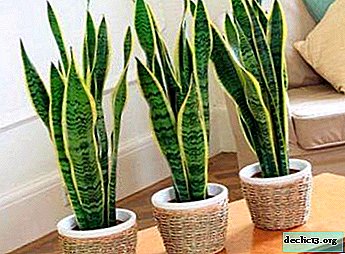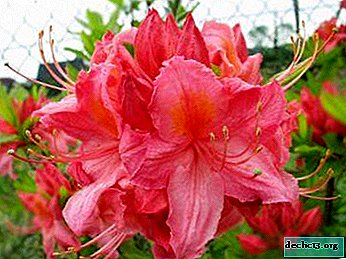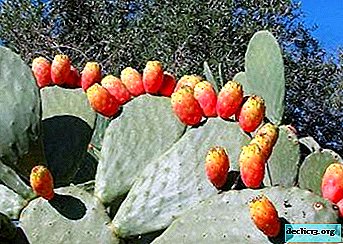All about exotic sansevieria: what is the peculiarity of the flower, is it possible to keep at home, how to take care?
 Exotic sansevieria occupies a leading position in the ratings of the most popular domestic plants. This is explained by its unpretentiousness, useful properties and the beauty of the bush. Succulent will fit perfectly and "green" the interior of any room: apartment, office, shop and even school classrooms. In everyday life, sansevier is an unpretentious houseplant - better known by the name of pike tail or others - mother-in-law's tongue, but there is no difference what to call it, all these concepts very accurately characterize the appearance of the succulent.
Exotic sansevieria occupies a leading position in the ratings of the most popular domestic plants. This is explained by its unpretentiousness, useful properties and the beauty of the bush. Succulent will fit perfectly and "green" the interior of any room: apartment, office, shop and even school classrooms. In everyday life, sansevier is an unpretentious houseplant - better known by the name of pike tail or others - mother-in-law's tongue, but there is no difference what to call it, all these concepts very accurately characterize the appearance of the succulent.
Detailed botanical description of sansevier
So, consider what kind of plant it is - an exotic sansevier. Sansevieria is an evergreen perennial. Most varieties are grassy; they do not have a stem. It is a succulent (accumulates and retains moisture in special tissues). A close relative of yucca and dracaena. Mother-in-law's language is part of the Asparagus family, an early subspecies was included in the Agave family.
Because of its unpretentiousness and ease of care, Sansevier is often called a plant for lazy people. The pike tail is completely capricious:
- withstands temperature extremes;
- for a long time without watering, does not require spraying;
- loves moderate light, but can grow in the shade;
- develops well in tight pots (transplanting is very rare).
The Latin name for the culture is sansevieria. Unusual folk names received due to the shape of the leaves. The pike tail is due to the striped and hard leaves, the mother-in-law's tongue is due to the long leaves.
Reference! In different countries, Sansevier is called differently. The Americans noticed the similarity of its sheets with reptile skin and called the plant "snake skin". The English call it the language of the Devil, and the Germans call it African hemp (only because of the fiberiness of the shoots, the sansevier does not have the intoxicating properties).All about her: homeland and habitat, external features in the photo
The culture has been known since the 18th century. The name was given in honor of the prince from Italy, who made a significant contribution to the development of botany. The name of the prince is Raymond de Sangro, the title is Prince von Sansevierio.
Features of appearance:
- Rosettes of leaves are dense, depart immediately from the root.
- The greens are fleshy, dense (moisture accumulates in it).
- Leaf plate colors vary by variety (dark green or even brown). There are longitudinal or transverse stripes. Some varieties have glossy leaves.
- The shape of the leaves is diverse: oval or long, flat or thick. There are xiphoid or shaped like a spoon or pencil.
- Leaves grow parallel up. In some cases (in rare varieties) they grow parallel to the ground or in different directions.
- The flowers are small, inexpressive. Have a yellow or white tint.
- Fruits are formed - small inedible berries.
Today many varieties and varieties of sansevier are bred. They differ in the color of the leaves, the length and shape of the rosettes. At home, the three-lane sansevier is most often grown. The plant is decorative and deciduous (grown for the sake of luxurious greenery, and not buds and flowers).
The birthplace of culture is tropical Africa. Natural habitats are subtropics, savannas, regions with sparse and rocky soil. These are the countries of Central Africa, Asia, India and Indonesia, America (South Florida), Sri Lanka and Madagascar.
Further on the photo you can see what a houseplant looks like - succulent of Sansevier:

The photo below shows a pike tail in a pot:

Is it possible to keep a pike tail at home?
This plant often decorates both apartments and houses, and public institutions. The pike tail is an effective natural air filter. But in the green parts of the plant contains saponins, which are poisonous in large numbers. Keeping at home and raising crops is permitted, but with some limitations.
- If there are small children or pets in the house who gnaw the plants, the pot with the sansevier should be placed above their access. If green parts get inside, dermatitis, intestinal upset, and poisoning are possible.
- Pure Sansevier juice is a toxic substance.
- It is not recommended to put pots with plants in children's rooms and bedrooms, as sleep may be disturbed.
About whether it is possible to keep this plant at home, we spoke in detail in this article.
Useful and healing properties
The benefits of sansevieria lie in the purification and enrichment of air with oxygen, green parts of the flower neutralize harmful fumes from furniture and plastic, destroy germs and bacteria. This flower in the house is a natural method of strengthening immunity and protecting against colds.
Rich in trace elements and biologically active substances, the composition allows you to actively use the culture in traditional medicine. The healing properties of sansevier:
- analgesic and anti-inflammatory effect;
- acceleration of wound healing;
- the fight against scabies, itching;
- relief from inflammation of the appendages of cystitis;
- tincture helps with infectious pathologies of the digestive tract.
All the details about the benefits and harms of sansevieria you will find here.
What you need to know about plant care?
| Component | Requirements |
| Shine | Enough moderate lighting without direct sunlight. |
| Temperature | The best indicator is at least 15 degrees. |
| The soil |
Use perlite or fine gravel for drainage. An alternative is to purchase ready-made primers for cacti in the store. |
| Watering | Not abundant and rare. Moisture should not get inside the outlet, as this provokes rot. Spraying is not necessary, but occasionally the leaves should be wiped off the dust with a damp, clean sponge. |
For information on how to properly care for and breed Pike tail, read a separate article.
Breeding
 At home, vegetative reproduction. Occurs in 3 main ways.
At home, vegetative reproduction. Occurs in 3 main ways.
- Division of the side layers of the bush. Cut the rhizome with a sharp knife, connect the parent plant and the process. Sprinkle the slice with crushed coal. Put in a new pot, pour. Layers take root within a month.
- Division of the root. Take an adult plant. To clean the dry roots from the root, cut them into pieces (at least 1 kidney should be on each root). Treat the sections with fungicide or charcoal, place in a new substrate.
- Leaf cuttings. Take the old lower leaves. Dry the cuttings in air, then put vertically in a moist mixture (peat, sand, vermiculite). Depth - 2 cm. Tamp the soil a little. Cover with a bag or jar on top, remove daily for ventilation. Roots of the cuttings will appear in 2-3 weeks, children - in - 1-2 months, stem cuttings - in 2-3 months.
We suggest watching a video about the propagation of sansevieria leafy cuttings:
Flowering at home
Teschin tongue can bloom when grown at home, but this rarely happens even with good care. The flowers are small, most often white. They are collected in a brush on a long stalk: form a peduncle. Peduncles may be several. Flowers have a pleasant but pungent smell.
On the video you can see how sansevieria blooms at home:
Pests and diseases
The main diseases are anthracnose and gray rot. In the first case, the leaves become covered with brown spots, their area gradually grows and as a result, the leaf dries. With rot, the leaves turn yellow, lose their elasticity, the stem becomes soft, mold smell comes from the soil or a characteristic white coating appears on it.
Possible pests of sansevier:
- Spider mite. Pale yellow leaves, thin cobwebs.
- Thrips. White dots appear on the leaf plate, which eventually become gray-brown spots. The sheet is covered with a silvery sheen.
- Mealybug. Deformation of the sheet, yellowing and dying.
Mother-in-law Succulents Language
These include plants from the Asparagus family or succulents with a similar arrangement of the bush. The plant has visual general similarities with the following cultures.
- Hippeastrum. Bulb culture. The leaves are shiny, linear, there are shallow grooves on the plate. When flowering, 1 powerful peduncle is formed.
- Bokarneya. This is a stunted tree that has a thick and swollen trunk at the base. At the top are long and narrow leaves.
- Dracaena. Dense foliage, diverging outlet. There is a flexible trunk. The plant reaches from 2 to 10 m.
- Yucca. Tree plant. The stem is small, not branching. The leaves are large, hard and xiphoid, collected in sockets. Inflorescences upright.
- Calla. It has a long and straight stem, elongated and not wide leaves (located below). The root is tuberous, thick.
So, Sansevier is a succulent from the Asparagus family. This is an evergreen, stemless, herbaceous plant. It is characterized by simplicity and ease of care. You can keep at home, but given some limitations.

















